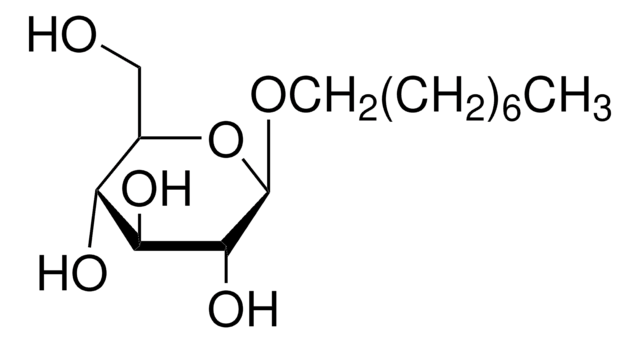494460
Octyl β-D-glucopyranoside
ULTROL® Grade, ≥99% (TLC), non-ionic detergent to solubilize membrane-bound proteins in their native state
Synonym(s):
n-Octyl-β-D-glucopyranoside, ULTROL® Grade, OG, n-Octylglucoside
About This Item
Recommended Products
Quality Level
Assay
≥99% (TLC)
form
solid
manufacturer/tradename
Calbiochem®
storage condition
OK to freeze
desiccated (hygroscopic)
aggregation number
84
impurities
≤0.05% n-octanol
color
white
CMC
20 - 25 mM
solubility
water: 100 mg/mL
shipped in
ambient
storage temp.
15-25°C
InChI
1S/C14H28O6/c1-2-3-4-5-6-7-8-19-14-13(18)12(17)11(16)10(9-15)20-14/h10-18H,2-9H2,1H3/t10-,11-,12+,13-,14-/m1/s1
InChI key
HEGSGKPQLMEBJL-RKQHYHRCSA-N
General description
Warning
Reconstitution
Other Notes
Levy, D., et al. 1992. Biochim. Biophys. Acta1107, 283.
Nunn, R.S., et al. 1992. J. Mol. Biol.228, 1259.
Lorber, B., et al. 1990. Biochim. Biophys. Acta1023, 254.
Jopski, B., et al. 1989. Biochim. Biophys. Acta978, 79.
Camm, E.L., et al. 1981. Plant Physiol.67, 1061.
Gould, R.J., et al. 1981. Biochemistry20, 6776.
Legal Information
Storage Class Code
13 - Non Combustible Solids
WGK
WGK 3
Flash Point(F)
Not applicable
Flash Point(C)
Not applicable
Certificates of Analysis (COA)
Search for Certificates of Analysis (COA) by entering the products Lot/Batch Number. Lot and Batch Numbers can be found on a product’s label following the words ‘Lot’ or ‘Batch’.
Already Own This Product?
Find documentation for the products that you have recently purchased in the Document Library.
Our team of scientists has experience in all areas of research including Life Science, Material Science, Chemical Synthesis, Chromatography, Analytical and many others.
Contact Technical Service



